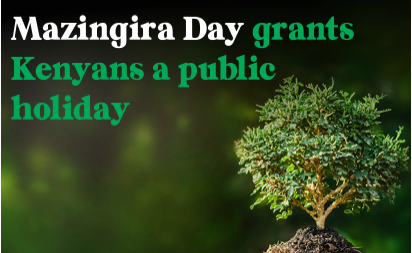Mazingira Day grants Kenyans a public holiday

Mazingira Day, celebrated every year on 10th October as a public holiday, serves as a vital reminder of Kenya’s dedication to environmental conservation and sustainability. Formerly known as Moi Day, this occasion has transformed into a significant platform for raising awareness about environmental issues. With the growing challenges posed by climate change, deforestation, and pollution, Mazingira Day provides an opportunity for the government and citizens to take meaningful actions toward a sustainable future.
The word “Mazingira” means “environment” in Swahili, highlighting the day’s focus on urgent environmental concerns in Kenya. The country, rich in biodiversity—from the Maasai Mara to the verdant forests of Mount Kenya—faces numerous challenges. Rapid urbanisation, agricultural expansion, and industrial activities have resulted in habitat destruction and increased greenhouse gas emissions. Mazingira Day underscores the need to protect these natural resources for the benefit of future generations.
Government initiatives and frameworks for environmental action
The Kenyan government has been actively pursuing various policies and frameworks designed to promote environmental sustainability. Below is a highlight of some of these initiatives.
- As a country, we have Vision 2030, a long-term development strategy that seeks to transform Kenya into a newly industrialised, middle-income country by 2030. A crucial element of this vision is sustainable development, which highlights the importance of conserving natural resources and advancing green technologies.
- The government launched the National Climate Change Action Plan (NCCAP III) 2023-2027 to build resilience against the impacts of climate change and encourage sustainable development. The plan focuses on adaptation strategies across multiple sectors, including agriculture, water, health, and energy. It seeks to enhance Kenya’s ability to respond to climate risks while also fostering low-carbon development pathways.
- Additionally, the government has set up the National Biodiversity Strategy and Action Plan (NBSAP) 2019-2030, a strategic framework designed to conserve biodiversity and promote the sustainable use of biological resources. It focuses on protecting ecosystems, species, and genetic diversity while encouraging community participation in conservation initiatives. The NBSAP is also aligned with international obligations under the Convention on Biological Diversity, directing efforts to combat biodiversity loss and strengthen ecosystem resilience.
- Recently, the government revised Kenya’s Forest Policy (2014) and formulated the Kenya Agroforestry Strategy (2020-2030), which highlights the importance of incorporating agroforestry practices into agricultural policies. This integration aims to boost food security, enhance resilience to climate change, and support sustainable land management. By promoting agroforestry systems, Kenya seeks to improve soil health, protect biodiversity, and increase carbon sequestration.
- The transition of Clean Development Mechanism (CDM) activities to the Article 6.4 Mechanism marks a significant shift, as the CDM, established under the Kyoto Protocol, officially concluded on December 31, 2023. Consequently, Kenya is moving its CDM activities to the new Article 6.4 Mechanism, which is designed to foster sustainable development and ensure that emission reductions align with the Paris Agreement. This transition is vital for sustaining Kenya’s efforts to lower greenhouse gas emissions and advance renewable energy initiatives.
Kenya’s key environmental targets and goals
The government has established ambitious targets to tackle environmental challenges, including:
- Planting 15 billion trees by 2030. This goal is part of a larger commitment to enhance Kenya’s tree cover and rehabilitate degraded lands.
- Reducing its greenhouse gas emissions by 32% by 2030, relative to a business-as-usual scenario, through a combination of mitigation and adaptation strategies.
- Committing to boost the share of renewable energy in the national grid to 70% by 2030, taking advantage of the country’s abundant geothermal and wind energy resources.
How Kenyans can celebrate Mazingira Day
There are numerous impactful ways for individuals and communities to embrace the spirit of Mazingira Day. You can:
- Participate in local tree planting projects or start your own in schools, parks, and neighbourhoods to increase green spaces.
- Engage in community clean-up activities to clear litter from beaches, parks, and urban areas, fostering a sense of environmental stewardship.
- Organise or join workshops that focus on sustainable practices, including recycling, waste management, and conservation efforts.
- Volunteer for or contribute to organisations that are committed to wildlife conservation and environmental protection.
- Adopt habits such as reducing plastic consumption, conserving water, and composting to help create a healthier environment.
- Utilise social media to spread awareness about environmental issues and promote events and initiatives related to Mazingira Day.
With a strong set of policies and initiatives in place, the Kenyan government is ready to lead in sustainable development. However, the active involvement of citizens is just as important.

